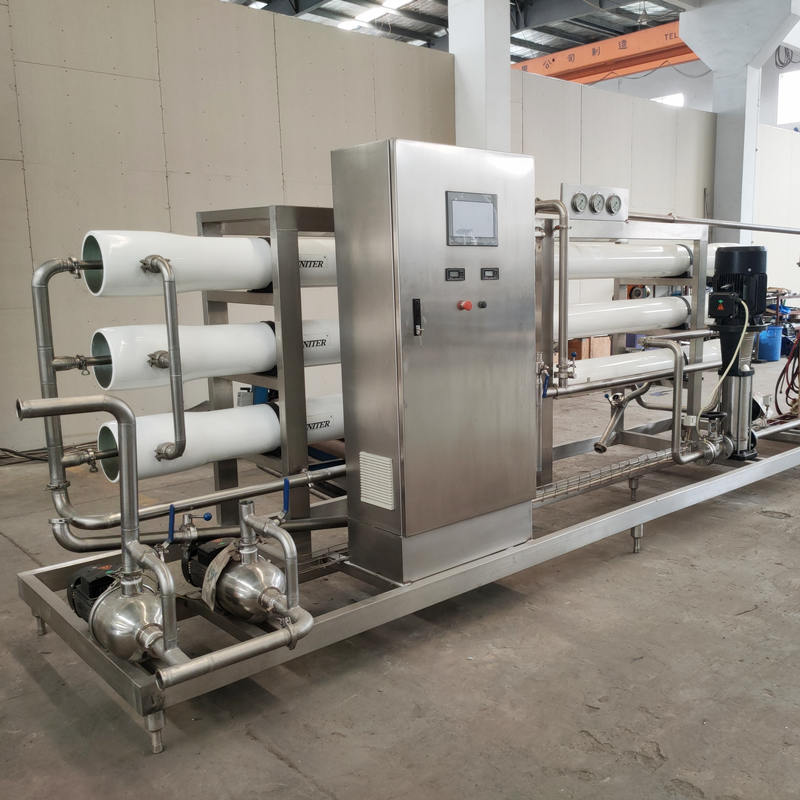
1. Technological process of pure water treatment (standard process)
Raw water tank→Raw water booster pump→Multi-medium filter (usually quartz sand filter)→Activated carbon filter→(Scale inhibitor)→Precision filter→Security filter→(Nanofiltration filter-for turbid water quality)→Buffer water tank (protective pump)→High pressure pump→RO reverse osmosis system→Ultraviolet / Ozone sterilization→Titanium rod filter→Product water or pure water tank→Filling machine
Tips:
1) Raw water booster pump function: increase the pressure of raw water to pass through the filter. Two raw water boost pumps and one is used to pressurize the raw water. Only two pumps are opened when backwashing the filter. In addition, there are no pumps before the multi-media filter and RO, only 2 pumps at the raw water tank.
2) Multi-media filter: used to filter large particles of impurities.
Activated carbon filter: activated carbon is used to absorb odor and color, and can also absorb residual chlorine if it is tap water.
The function of security filter: protect RO membrane.
3)The recovery rate of one-stage RO membrane is about 75%. According to the water quality report and the country’s requirements for purified water, it is decided when to use two-stage RO. The hardness of water quality (hardness) is low, and the one-grade RO membrane is used. With high hardness, the softener (demineralizer), that is, ion exchanger, mainly softens calcium and magnesium ion. Adding salt as the medium (sodium ion), the water softener uses ion exchange technology to exchange divalent ions such as calcium and magnesium in the raw water through the functional ions on the resin. thus adsorbing excess calcium and magnesium ions in the water, sodium ions will not accumulate on the object surface in the form of scale after exchange, so as to achieve the purpose of removing scale (calcium carbonate or magnesium carbonate).
The recovery rate of RO membrane = (water production flow rate / influent flow rate of RO membrane) × 100%.
4) Is there any difference in the process between one-stage RO and two-stage RO: basically no, while the secondary RO is filtered twice in one machine.
5) The RO reverse osmosis system needs regular cleaning and positive washing, because the RO membrane can not be backwashed, otherwise the RO membrane will be destroyed.
CIP cleaning water tank, after pump, precision filtration, adding medicine-citric acid (citric acid).
6) The function of titanium rod filter:
(1) Intercept impurities that may exist in the pipeline
(2) After ozone sterilization, using other filters will cause great corrosion to the filter.
Titanium rods are resistant to ozone, so only titanium rod filters are used after ozone sterilization.
7) Pre-processing: The main results are as follows:
(1) To prevent scaling on the surface of reverse osmosis membrane, mainly some oxides.
(2) Prevent pollution and blockage of colloidal substances and suspended solid particles.
(3) Prevent organic pollution and blockage.
(4) Prevent microbial contamination and blockage.
(5) To prevent the oxidative damage of RO film caused by oxidizing substances.
(6) To ensure the water temperature of the inlet water-increase the plate heat exchanger to maintain the stability of the water production of the reverse osmosis device.
8) The effluent capacity of RO membrane will decrease with the decrease of water temperature.
The best temperature for water production of RO membrane is 20-30℃.
9) Bag filters are generally not used for water treatment.
— for pre-deployment.
10) RO, ultrafiltration pump: the preferred CNP pump, many service outlets, more convenient to buy accessories, more convenient after-sales maintenance.
Ro membrane manufacturers:
1 American Film Tec Company, which became a wholly owned subsidiary of American Dow Chemical Company in 1985.
2 American Hydranautics company, which became a wholly owned subsidiary of Nitto Electric Company of Japan in 1987.
3 Toray Co., Ltd., founded in 1926 and headquartered in Tokyo, Japan, is a world leading comprehensive high-tech enterprise with organic synthesis chemical industry, polymer chemistry and biochemistry as its core technology.
Water quality: conductivity is different: mineral water contains some ions, the conductivity will be higher than pure water.
2. Technological process of mineral water treatment
Raw water tank→Raw water booster pump→Multi-media filter (usually quartz sand filter)→Activated carbon filter→Precision filter→Security filter→Buffer water tank→Booster pump→Ultrafiltration unit→Ultraviolet / ozone sterilization→Product water tank→Filling machine
Tips:
Mineral water is water containing dissolved minerals or more gases. The nine limit indexes stipulated in the national standards include lithium, strontium, zinc, selenium, bromide, iodide, metasilicic acid, free carbon dioxide and dissolved total solids. There must be one or more items in mineral water that meet the requirements of the limit index. The required contents are: lithium, strontium, zinc, iodide ≥ 0.2, selenium ≥ 0.01respectively (unit: mg/L).
Bromide ≥ 1.0, metasilicic acid ≥ 25, free carbon dioxide ≥ 250 and dissolved total solids ≥ 1000.
Most mineral water on the market belongs to strontium type and metasilicic acid type, as well as mineral water with other mineral ingredients.
